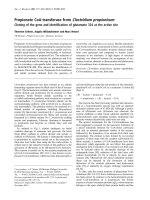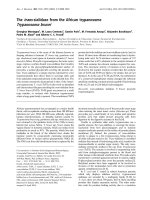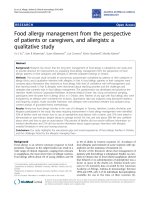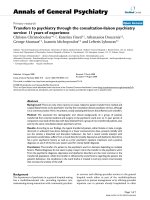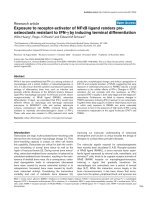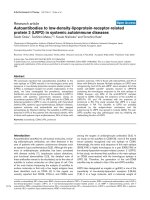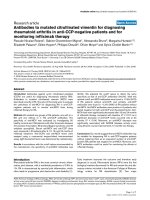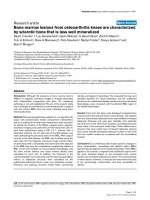Báo cáo y học: " Ways to get from plant genomes to phenomes: via yeast" ppsx
Bạn đang xem bản rút gọn của tài liệu. Xem và tải ngay bản đầy đủ của tài liệu tại đây (50.64 KB, 2 trang )
Genome Biology 2005, 6:310
comment
reviews
reports
deposited research
interactions
information
refereed research
Meeting report
Ways to get from plant genomes to phenomes: via yeast
Pablo D Rabinowicz and Willem Rensink
Address: The Institute for Genomic Research, 9712 Medical Center Drive, Rockville, MD 20850, USA.
Correspondence: Pablo D Rabinowicz. E-mail:
Published: 15 February 2005
Genome Biology 2005, 6:310
The electronic version of this article is the complete one and can be
found online at />© 2005 BioMed Central Ltd
A report on the Cold Spring Harbor Laboratory meeting
‘Plant Genomes: From Sequence to Phenome’, Cold Spring
Harbor, USA, 9-12 December 2004.
Whole-genome sequencing, although not yet a routine
laboratory technique, is certainly becoming more affordable,
and increasing numbers of nearly complete eukaryote
genomes are relentlessly being added to the list. Making
sense of the resulting overwhelming amount of sequence
may require an equal effort. Several high-throughput tools
for automated identification of genes at the structural
level are available, but functional annotation can only be
tentatively inferred on the basis of sequence motifs or
sequence similarity. ‘Gold standard’ structural and functional
annotation still requires extensive human intervention to
eliminate frequent errors. The next challenge is to investigate
how a genome sequence determines the phenotype of the
whole organism (sometimes referred to as the ‘phenome’).
The way in which each protein contributes to the pheno-
type depends on a variety of factors such as regulation of
expression, interaction with other proteins or nucleic
acids, response to small molecules, subcellular localization,
and so on. Technologies for genome-wide analysis of gene
expression such as microarray hybridization are now com-
monly used and genome-wide analyses of protein-protein
or protein-DNA interactions (the ‘interactome’) are emerging.
The complexity of higher eukaryotic genomes makes
analysis difficult, however, particularly for interactomes.
This was reflected in a meeting on the functional analysis
of plant genomes held last December in Cold Spring
Harbor, where most of the results presented on interactome
analysis were in fact carried out on the less complex
genome of yeast.
A paradigm for this approach is a yeast synthetic genetic
array (SGA) analysis described by Charles Boone (University
of Toronto, Canada). Out of the 6,000 yeast genes, 5,000
have been shown to be non-essential in a genome-wide
single-gene-knockout project, but double mutants of these
non-essential genes often have lethal phenotypes (synthetic
lethal phenotypes). SGA analysis allows the identification
of genetic interactions, because if a double mutant has a
synthetic lethal phenotype the two corresponding wild-type
genes often have a functional relationship. By testing 132
genes as double mutants with each of the other 5,000
non-essential genes, Boone and his colleagues determined
that each gene has an average of 30 synthetic genetic
interactions and that there may be 100,000 such interactions
in the yeast genetic network. Furthermore, they observed
that physical (protein-protein) interactions and genetic
interactions do not overlap because redundant protein
complexes are present. Thus, one mutant protein in each
complex yields a lethal phenotype whereas two mutant
proteins in the same complex will be buffered by the other
complex, resulting in a viable phenotype. They also showed
that, using cluster analysis of SGA results, the function of
an unknown gene could be predicted on the basis of the
genes with which it is connected in the SGA network. SGA
analysis paints a much more complex picture of the yeast
interactome than previously reported protein-protein
interaction networks alone. As SGA and protein-protein
interaction networks are not complicated enough for Boone,
his team is now moving towards SGA analysis of essential
genes using inducible gene constructs. Although plants have
several times more genes than yeast, large collections of
knock-out mutants and high-throughput protein expression
resources give us hope that this type of study will soon be
feasible in plants.
Progress is being made towards understanding complex
plant systems through the development of new technologies.
A new in vivo analysis method for computational modeling
of shoot apical meristems (SAMs) has been developed by
Elliot Meyerowitz (California Institute of Technology,
Pasadena, USA). He described how the method takes
advantage of in vivo confocal laser-scanning microscopy
of Arabidopsis meristems. First, all cells are visualized
using yellow fluorescent protein (YFP) fused to a plasma
membrane protein, which enables cell divisions to be followed
over time. In a second step, fluorescent protein fusions to
gene products that are localized to the three different
meristematic zones (central zone, peripheral zone and rib
meristem) enable the identity of each cell in the meristem
to be determined. As an example of how this technology
can be used to dissect meristematic functions, Meyerowitz
described how inducible overexpression of WUSCHEL
(normally expressed in the rib meristem and a repressor
of CLAVATA3, which is expressed in the central zone)
resulted in an expansion of the central zone, as revealed
by the presence of a fluorescent version of the CLAVATA3
protein outside its normal boundaries. These results, com-
bined with the results of the cell-division timing experiment,
enabled his team to determine that WUSCHEL respecifies
peripheral meristem cells as central zone cells rather than
increasing cell division in the central zone. The challenge
now is to automate the data-acquisition process for large-scale
analyses. For this purpose, a fluorescent histone fusion
protein is used as a nuclear marker and software is being
developed to automatically locate and track the nuclei as
cells move and divide. Data of this type should enable
computational modeling to identify all the meristem cells
and eventually follow their lineages as they become part of
the three different meristematic zones.
Small RNAs are emerging as important regulatory molecules,
and high-throughput discovery of small RNAs can provide
a comprehensive view of their function. Pamela Green
(University of Delaware, Newark, USA) described how she
and her collaborators have developed a sequencing
method to identify and quantify these RNA molecules by
modifying the massively parallel signature sequencing
(MPSS) technology. There are two kinds of small RNAs:
microRNAs (miRNAs) and small interfering RNAs
(siRNAs). The former are derived from hairpin-containing
precursors and the latter originate from double-stranded
RNAs through the action of an RNA-dependent RNA poly-
merase (RDR). Green reported the first truly genome-wide
analysis of small RNAs, which showed that small RNAs are
widespread in the Arabidopsis genome and that differential
silencing occurs between different tissues. Furthermore,
siRNAs can be distinguished from miRNAs by northern-
blot hybridization of small RNAs against wild-type and
RDR mutants.
As more and more genome sequences are completed, com-
parative analyses become more effective in gene discovery
and even in determining gene function. In a compelling
example of such a study, Susan Dutcher (Washington Uni-
versity, St. Louis, USA) reported the use of cross-kingdom
genomic comparisons to identify a gene responsible for a
rare human disease. A comparison between the proteomes
of the alga Chlamydomonas reinhardtii and humans
(both of which have flagellate cells, despite being other-
wise very different) resulted in around 4,000 proteins
shared by both species. When proteins present in Ara-
bidopsis (a non-flagellate organism) were subtracted, 688
proteins remained. This set contained most flagellum-
related proteins, including a human protein that shows
similarity to a Chlamydomonas flagellar protein and is
encoded in a region of the genome containing one of the
genetic loci (BBS5) known to be responsible for Bardet-
Biedl syndrome, a complex disease that is believed to be
caused by defects in flagellar function. This correspon-
dence enabled identification of the BBS5 gene as encoding
a flagellar protein; there is a correlation between muta-
tions in BBS5 and Bardet-Biedl syndrome and further
analysis of the BBS5 gene confirmed its function and
involvement in the disease.
Intra-kingdom genome comparisons are also useful in the
understanding of plant biology and evolution, but the plant
species for which genome sequences are available span
only 200 million years of land plant evolution. Fortunately,
as announced by Jody Banks (Purdue University, West
Lafayette, USA) in her presentation, the genome of the
ancient seedless plant Selaginella moellendorffii will soon
be sequenced, adding another 200 million years of evolu-
tionary history to comparative plant genomics. It is estimated
that its compact, gene-rich genome is less than 100
megabase-pairs (Mb) long and contains homologs of most
known and putative plant genes as well as genes not
present in angiosperms.
For small genomes, a high level of refinement can be
achieved by intra-species comparisons. Mark Johnston
(Washington University School of Medicine, St. Louis,
USA) reported on the identification of functional features
in the non-coding sequence of yeast. By sequencing six
closely related and divergent yeast strains, putative target
sequences of transcriptional regulators could be identified.
Intra-specific comparative analysis of the Arabidopsis
genome is also becoming a reality. A high-resolution geno-
typing study of 20 Arabidopsis accessions using oligo-
nucleotide microarrays was presented by Justin Borevitz
(University of Chicago, USA). Among the polymorphisms
investigated, disease resistance-like genes and genes for
receptor-like proteins, for example, show higher levels of
variation than genes for basic helix-loop-helix DNA-
binding proteins.
The new tools, technologies and genomes available for plant
biology will sooner or later allow plant phenome research
to catch up with the rapidly growing yeast field. We hope
to be listening to many more exciting plant proteomics,
phenomics, and interactomics talks at the next Cold Spring
Harbor Plant Genome meeting in 2007.
310.2 Genome Biology 2005, Volume 6, Issue 3, Article 310 Rabinowicz and Rensink
Genome Biology 2005, 6:310

